Climate change challenges blackcurrant growers
Blackcurrant growers all over the world regularly report about increasing difficulties related to climate change. Drought, heat, lack of winter chill and spring frost work their own way and indirectly lead to controlling blackcurrant overproduction “naturally”.
The background
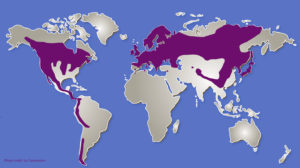 Before we talk about new challenges related to climate change, let’s have a look at the basics. Blackcurrants grow naturally in temperate climate. Their home is the region spanning between the tropics and the polar regions of Earth. They need distinct seasonal changes: warm summers and cold winters.
Before we talk about new challenges related to climate change, let’s have a look at the basics. Blackcurrants grow naturally in temperate climate. Their home is the region spanning between the tropics and the polar regions of Earth. They need distinct seasonal changes: warm summers and cold winters.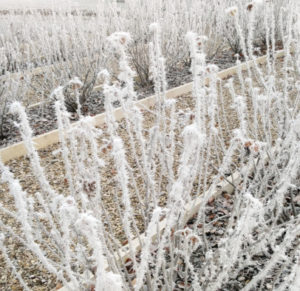 The blackcurrant is not very demanding in terms of soil, sunshine and water. The natural conditions in its climatic zone are perfect, and the plants don’t require special layouts. They just grow – and give a good yield. Mechanical harvesting has developped in the 1980ies and made it easy for growers to harvest huge quantities of blackcurrants within a few days and with very few workers. The juice concentrate business paid good prices for blackcurrants for several years, and growers could earn a good living. It sounds like paradise.Then came overproduction, and what had been a dream world for many has become a nightmare within a few years. The blackcurrant growing surface kept growing, and resulted in overproduction, especially in Poland. This naturally led to lower prices.Today, the situation starts getting back to normal, as the production in Poland decreases little by little and corresponds more to what the market demands.
The blackcurrant is not very demanding in terms of soil, sunshine and water. The natural conditions in its climatic zone are perfect, and the plants don’t require special layouts. They just grow – and give a good yield. Mechanical harvesting has developped in the 1980ies and made it easy for growers to harvest huge quantities of blackcurrants within a few days and with very few workers. The juice concentrate business paid good prices for blackcurrants for several years, and growers could earn a good living. It sounds like paradise.Then came overproduction, and what had been a dream world for many has become a nightmare within a few years. The blackcurrant growing surface kept growing, and resulted in overproduction, especially in Poland. This naturally led to lower prices.Today, the situation starts getting back to normal, as the production in Poland decreases little by little and corresponds more to what the market demands.
Climate change – the new challenge
But now come up new challenges – and they are not only related to “new” countries present in the market (which will have an impact on the quantity of blackcurrants and on prices). The “traditional” growers are now facing huge challenges related to climate change. It has only just started, but will bring much more difficulties than a deregulated market.A grower may have a certain amount of blackcurrants in his fields to reach the market’s demand. Nevertheless, weather conditions have a huge influence on the real yield. Therefore, the same grower may one year not be able to have a suitable yield. And in the next year, he may have too much blackcurrants for the needs of the market. No possibility to predict what will happen.Until lately, this was normal, and any agriculturer could cope with it – it was part of the business. Yet, the situation is different today: these natural variations have come into proportions where nobody can be sure to earn his living in agriculture. The collection of harvest estimations within the IBA show it: the yields may vary considerably until the very last minute. And as long as the blackcurrant harvest is not over, nobody can be sure to have the expected yield.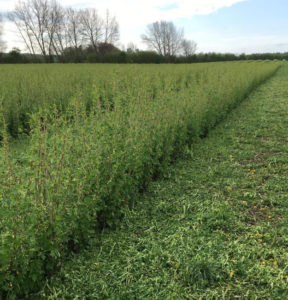
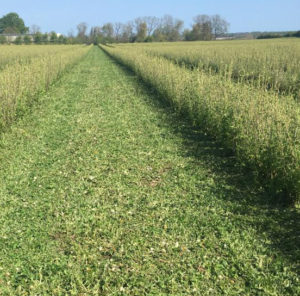
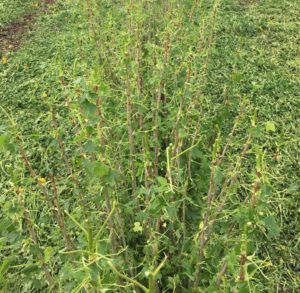
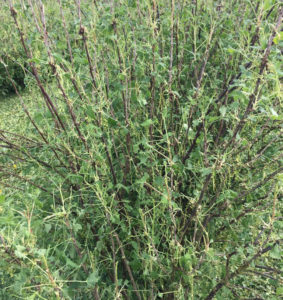
A few minutes of hail destroyed the bushes of a blackcurrant grower in Denmark. This kind of event has an impact not only on the yield in the same year, but also reduces the yield of the coming years.
Drought, heat, pests, frosts, hail – there is no limit in the potential problems a grower has to face every year. And presumably, they will change from one year to the other.
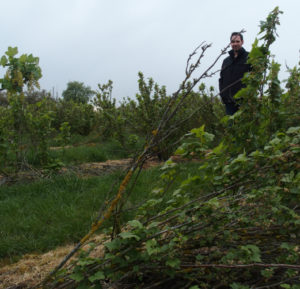
blackcurrant field in Germany, where bushes had suffered from drought
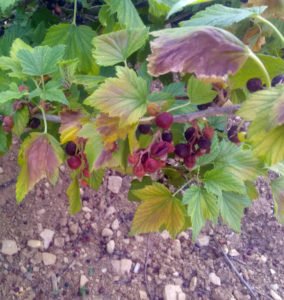
blackcurrants dry out on the bush and drop just before harvest in France
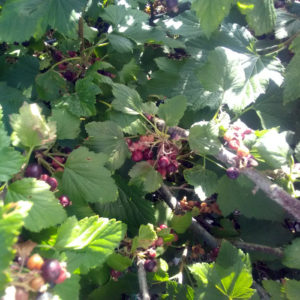
blackcurrants cannot stand too much heat
Warmer winters, more spring frosts
Lucozade Ribena Suntory and the James Hutton Institute have already started to work on adapting blackcurrant varieties to the new climatic conditions (read further). It is becoming increasingly difficult to obtain enough winter chill for the plants. Commonly speaking, we can all see that there is less snow and frost in winters. Whilst most of those born before 1990 and living in the Northern hemisphere always had a few weeks with snowfall every year and at least two or three weeks of continuous frost in winter, this is not the case for the younger generations. It has become rather exceptional. Tourism in the Alps is changing into hiking, and the possibilities for skiing are declining.No doubt, the mean temperature is increasing. At the same time, the variance of daily temperature increases. This also increases the risk of spring frost. This phenomenon is not limited to blackcurrants. But as the blackcurrant bushes are among the first to blossom and set fruits, this – again – is a big challenge for many growers.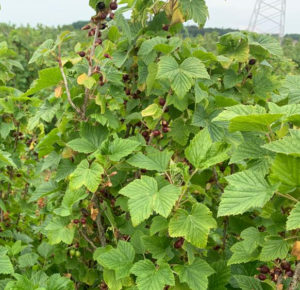 Over the past years, we have regular reports from growers who complain that part of their harvest – if not all – is destroyed within a single night of frost in April / May.
Over the past years, we have regular reports from growers who complain that part of their harvest – if not all – is destroyed within a single night of frost in April / May.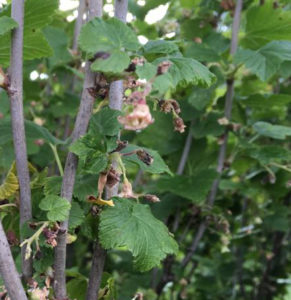
The effects of Climate change on water supply
We can observe a tendency for wetter winters. On the other hand, summers are getting drier, and thus the most important period for vegetation. We have more and more days of big heat every year. At the same time, evaporation increases significantly. As a consequence, the atmosphere is charged with water. This water comes back on the earth in the form of strong rain, thunderstorms and hail. In a very short period of time, the soil should absorb huge quantities of water – but cannot. Most of the water goes directly into the rivers, and from there into the sea. Instead of filling the phreatic zone and keeping the water table saturated.Currently, there is no water management adapting to the needs of all: agriculterers, industry, drinking water supply and protection of the nature. Everywhere, we need water. And every party has different interests. European countries, whether it is in France, Germany, the United Kingdom, Poland or any other country – naturally have enough water. But still not enough when it comes to the season when it is most needed. This is true also in the Southern hemisphere: a study with wine growers in New Zealand reports an increase in frost and wind, as well as a lack of water.
Pests and deseases
Together with the new climatic conditions come new pests and deseases in the plants. A good example may be the problem of scales, which the French growers had to solve over the past 10 years. For a long time, they were looking for different ways of coping with the pest and eradicate it.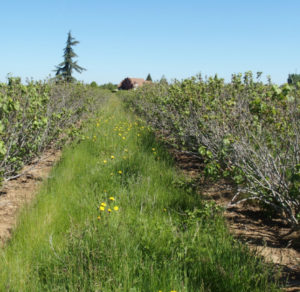 The blackcurrant fields of Burgundy are almost the farthest South in Europe. And although the variety may play a major role in the problem with scales, they now appear also further North. Is there a relation with the climate change? We cannot foresee this yet, but it is a possibility. Together with changing conditions as far as temperatures and humidity are concerned, deseases will develop or decrease accordingly.
The blackcurrant fields of Burgundy are almost the farthest South in Europe. And although the variety may play a major role in the problem with scales, they now appear also further North. Is there a relation with the climate change? We cannot foresee this yet, but it is a possibility. Together with changing conditions as far as temperatures and humidity are concerned, deseases will develop or decrease accordingly.
Looking for answers to climate change
It has already become evident that biodiversity helps to guarantee a more sustainable way of growing. In several countries, different approaches tend towards this. Some growers in Poland recommend to plant flowers at the end of the rows of blackcurrants. The horticultural advisor of the blackcurrant growers in the United Kingdom recommends to plant hedges around the blackcurrant fields. A grower in France reports difficulties with drought and strong wind – and starts planting hedges to protect the crops. These are only a few examples of what some of the growers already develop. And it gives back hope.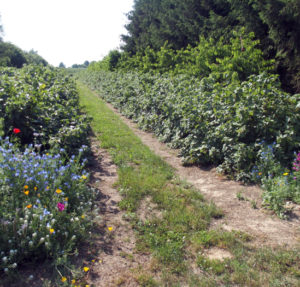
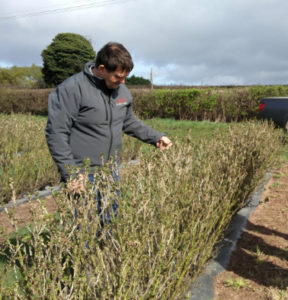
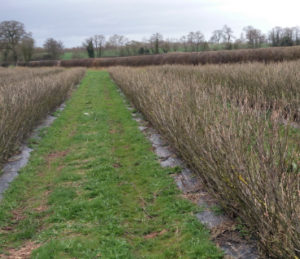
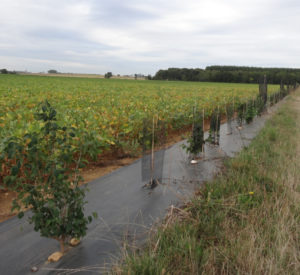 Nevertheless, there is still a long way to go. But unfortunately, we are running out of time. It is time to act, more than to think. Because one thing is sure: we will first see and suffer from the effects of climate change in agriculture.
Nevertheless, there is still a long way to go. But unfortunately, we are running out of time. It is time to act, more than to think. Because one thing is sure: we will first see and suffer from the effects of climate change in agriculture.